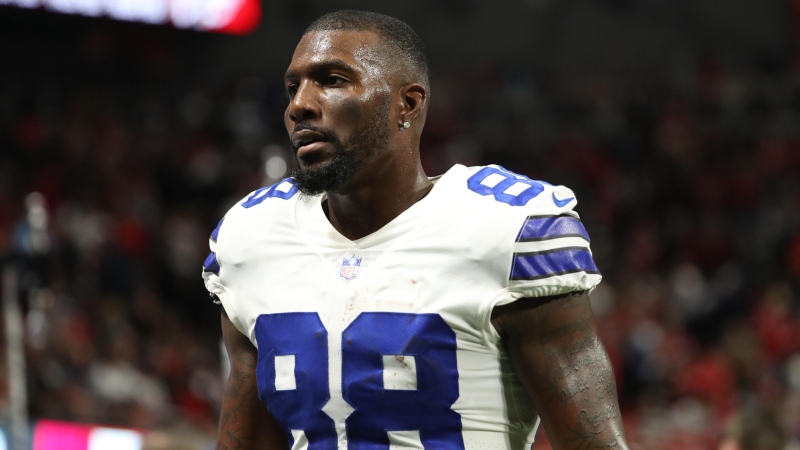Way back when I was in my prime — before all the sex and drugs blogging and data collection — I wrote some books. The Fantasy Sports for Smart People collection is the best-selling fantasy sports and DFS book series of all time. Is that actually true? I don’t know. And if I don’t know, you don’t know, which means I can just say it.
I have maybe a million words of content that I wrote in such a way that it mostly holds the same value now as it did when I first put fingertips to keyboard. No guarantees on the actual quality — just that it’s about the same.
I’ve always been interested in public psychology and how it affects our perception and the ways in which we process information — and, more specifically, how to exploit inefficiencies in the ways people think to make real American doll-hairs. So I’m going to post some excerpts from my books — mostly centered around cognitive biases — that I think should be useful for both fantasy sports players and bettors heading into the NFL season.
Without further ado, The Jonathan Bales List of Psychological Biases to Avoid for Grown-ups That Can’t Gamble Good and Want to Do Other Things Good Too . . .
Endowment Effect
The tendency for people to demand much more to give up an object than they would be willing to pay to acquire it
I don’t think there’s any better example of the endowment effect than in season-long fantasy football leagues. For every legitimate trade offer sent, there are dozens of Andy-Dalton-for-Antonio-Brown offers. I swear my Uncle Bruce once offered me a mid-30s Keenan McCardell for T.O. in his prime. Bruce also called my cell phone the other day and left this message:
“Hey Jon!”
(long pause)
“You there?”
(long pause)
“Hey pick up if you’re there!”
(long pause)
“You there Jon?”
(heavy breathing)
*hangs up*
My cell phone isn’t hooked up to a fucking answering machine, Bruce.
Anyway, people just cannot deal with giving something up. There’s a lot of research that suggests that when people are given something relatively meaningless to them — such as a pen — the price they’re willing to accept to sell the pen is about double what they say they’d be willing to pay for it. This loss aversion is what leads to so few trades in most traditional fantasy leagues.
We don’t have to deal with the endowment effect as much in daily fantasy football, but it’s related to your willingness to change your roster. So many people fear changing their initial lineup and then doing worse, but the combination of players you had at any point in time is irrelevant to which combination is optimal right now.
How to Overcome/Exploit It
The main way in which the endowment effect is relevant in DFS is with late-swap. So few people utilize late-swap except for injuries or late scratches, but it’s a massive potential edge. Some people avoid it because it’s extra work, but I think some also have a fear of changing their lineup.
With the passing of each minute in an NFL weekend, we have more and more information about where our lineup stands in relation to others, and we should utilize that information to edit the lineup accordingly. If you start cold in the 1 p.m. ET games and you’re an underdog to cash, you’re better off being more contrarian with your late-game players to give yourself a chance to come back, for example.
The information you have on hand at any given moment — and not what your lineup looked like in the past — should dictate how you structure it moving forward.
Gambler’s Fallacy
The tendency to think that future probabilities are altered by past events, when in reality they are unchanged. The fallacy arises from an erroneous conceptualization of the law of large numbers. For example, “I’ve flipped heads with this coin five times consecutively, so the chance of tails coming out on the sixth flip is much greater than heads.”
If you’ve ever walked into a casino, you’ve almost assuredly seen the gambler’s fallacy at work. It’s actually pretty nuts how many people think red is “due” in roulette, for example. Past results don’t affect future probabilities for random events.
You might be saying, “But earlier in this book you gave an example about coin-flipping and predicting when more heads or tails would come up.” You might be thinking that, anyway. If you’re literally speaking out loud as you read this article then there’s a decent chance you’re too crazy to be a successful DFS player, so just go ahead and get back to where you left off in The Secret.
The reason coin-flipping can be predictable is because of regression toward the mean, which takes place over large samples; we know 1,000 coin flips will be near 50% heads and 50% tails without being able to favor heads or tails on any single flip. Thus, we’re likely to see fewer heads over a series of 10 coin flips after an outlier of nine heads in 10 flips—not because there’s some mysterious force acting on the coin or because tails needs to “catch up,” but rather because the most likely outcome from the start is 50% tails.
I think the gambler’s fallacy is so strong because people have such a difficult time understanding regression toward the mean. When Aaron Rodgers starts a game 10-for-10 in the first half, his second half is likely to be far less accurate, but only because he was never likely to go 10-for-10 to start. We see regression toward the mean because each individual event is likely to bring us closer to the original baseline (assuming that baseline remains unchanged). The most likely number of heads after 10 flips is five, and that’s true even if the previous 100 flips were all heads or all tails.
The gambler’s fallacy can be so strong of an influencer in decision-making because people tend to “act” after outlying events. Some examples:
- In 1913, gamblers lost countless money betting against black in roulette because it began to come up so often. The roulette wheel showed black 26 straight spins, with many betting on red again and again after a few spins because “red was due.” The odds of a roulette ball landing on black 26 straight times is roughly 1-in-67-million—which is the same probability of any other specific sequence of red and black, i.e. It’s not likely one color will come up 26 times in a row, of course, but it’s also not likely any other particular sequence of red and black will land, either.
- A coach yells at players after they perform very poorly and praises them after doing extremely well. They perform better after getting yelled at and worse after being praised, causing the coach to change his approach and just start bitching at people a whole lot. Nothing will change, of course, since the players’ results will get better after being exceedingly bad and worse after being incredibly good simply because those were outlying performances and not sustainable, regardless of getting yelled at or not. A lack of understanding of regression is a big reason being a dick is often viewed as a quality approach to leadership.
- A man and woman want to have three children, both boys and girls. After three children are born and they’re all boys, the couple decides to have another child because they think it’s most likely to be a girl.
One potential problem in applying the gambler’s fallacy to football is that the sport isn’t random. However, once we establish a baseline rate — or at least a fair estimate of one — we can then predict when certain events will regress toward the mean.
As an example, if Tavon Austin starts the year scoring four touchdowns on 10 red zone targets, we can be fairly confident that red zone touchdown rate of 40% will drop. Meanwhile, that same number for Gronk is much more likely to hold up.
How to Overcome/Exploit It
Falling victim to the gambler’s fallacy is all about underestimating the amount of variance in football. It’s ironic, but I think this is very much the result of players being so skillful. The closer players are in relative skill levels—which is inevitable as teams take a more serious approach to sports science—the more volatility there is in the results. Playing LeBron James one-on-one leads to no variance in outcomes, whereas playing someone of your skill level makes the results more or less random.
Because so many undervalue football’s variance, they end up placing too much emphasis on recent performance when it isn’t warranted. So much of daily fantasy football is simply recognizing which situations have been temporary, unsustainable outliers.
The big area of DFS play in which you need to be cognizant of the gambler’s fallacy is bankroll management. I’ve seen players adjust their play both ways, with some putting down less action when struggling because they’re “cold” and others playing more because they’re “due.” Unless you think your mindset and process actually change from week to week, your most likely outcome in any given week is your long-term ROI. If you make 10% over the long run, you can expect to turn your $1,000 in action into $1,100 regardless of whether you won or lost last week.
Photo credit: Philip G. Pavely-USA TODAY Sports
Pictured: Antonio Brown








